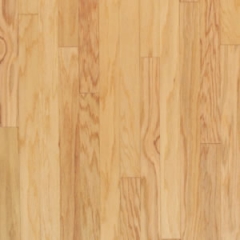Engineered Oak Flooring
 Red and white oak are both known for high shock resistance and durability, and these two types of hardwoods have several differences and similarities. Both have open grain and a porous appearance, which make oak hardwood ideal for staining. When both are plain sawn, the wood has a plumed appearance. When rift sawn, both hardwoods have a tighter grain pattern, and quarter sawn red and white oak takes on a flake or tiger stripe pattern. Additionally, both red and white oak flooring are resistant to splitting and have good holding ability.
Red and white oak are both known for high shock resistance and durability, and these two types of hardwoods have several differences and similarities. Both have open grain and a porous appearance, which make oak hardwood ideal for staining. When both are plain sawn, the wood has a plumed appearance. When rift sawn, both hardwoods have a tighter grain pattern, and quarter sawn red and white oak takes on a flake or tiger stripe pattern. Additionally, both red and white oak flooring are resistant to splitting and have good holding ability.
Red oak is known for having heartwood and sapwood of the same color, a light red shade. 200 species of red oak can be found in North America, and all have varying color combinations. With a Janka scale rating of 1290, red oak flooring sands well and is ideal for bleached floors.
White oak hardwood can have white, cream-colored, or light brown heartwood and sapwood and has longer rays but less grain variation when cut. Slightly harder than red oak, white oak has a Janka scale rating of 1360. Although better for machining than red oak, white oak has a high concentration of tannic acid, which makes the wood less ideal for bleaching. The tannic acid, however, wards off fungi and insects.White and red oak hardwood is available as engineered flooring. If you want to add oak flooring to any location in your home, including the basement, go with engineered oak flooring. In general, engineered flooring is composed of three to nine layers, or veneers, glued together, and the grain of each faces a different direction. The varied grain makes the wood expand and contract less from heat and moisture and is more stable than solid hardwood.
The top layer of engineered oak flooring is high-quality hardwood, and the under layers are of the same or a different species. The number of layers generally does not matter in installation, unless you plan to add engineered oak flooring over radiant in floor heat. Because of the humidity and temperature, more layers result in better stability.
Engineered oak flooring can be placed anywhere in your home and on top of any subfloor, including concrete. The wood can be glued down, stapled, or floated on top of a subfloor. Floating engineered oak wood is not secured directly to the subfloor; rather, the hardwood is suspended above and rests on cushioned underlayment. Planks of floating engineered oak wood can be glued, clicked, or attached by lock and fold.
